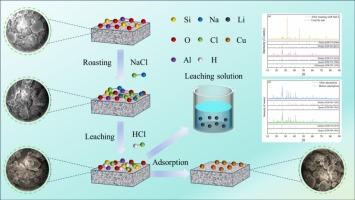煤飞灰中Li的高效浸出及浸出渣去除废水中Cu(ii)的应用:新的废物价值转化方法
IF 5
2区 工程技术
Q1 ENGINEERING, CHEMICAL
引用次数: 0
摘要
粉煤灰是一种重要的工业固体废弃物,对环境构成了严峻的挑战,而重金属污染水的治理仍然是全球关注的问题,锂在支持全球经济和技术进步方面发挥着不可替代的作用。因此,为了克服战略金属供应有限和环境威胁的双重挑战,本研究开发了一种可持续的方法,用于从CFA中高效浸出锂(LRCFA)并利用浸出渣从电镀废水中去除Cu(ii)。焙烧浸出实验表明,在最有利的实验条件下,元素Li的浸出率高达95.33%。环境风险评估确认所有固体残留物中重金属的可浸出性符合相关环境标准,确保其环境安全。在pH为6 ~ 7的条件下,LRCFA对Cu(ii)的吸附和去除效果明显优于CFA和焙烧渣(RCFA)。LRCFA对Cu(ii)的吸附符合拟二级动力学和Langmuir模型,Cu(ii)的最大吸附量为41.76 mg/g。机理分析结果表明,NaCl的焙烧破坏了CFA结构,增强了Li的浸出性,而生成的LRCFA的Si-O-Al框架通过离子交换和与表面官能团的络合促进了Cu(ii)的结合。这项工作证明了固体废物在关键金属回收和废水修复方面的宝贵利用。本文章由计算机程序翻译,如有差异,请以英文原文为准。

Efficient leaching of Li from coal fly ash and application of leaching residue for removal of Cu(ii) from wastewater: New waste-to-value approach
Coal fly ash (CFA), a significant industrial solid waste, presents environmental challenges, while the management of heavy metal contaminated water remains a global concern, and lithium (Li) plays an irreplaceable role in supporting global economic and technological progress. Consequently, to overcome the double challenge of limited supply of strategic metals and environmental threats, a sustainable process for the efficient leaching of lithium from CFA (LRCFA) and removal of Cu(ii) from electroplating wastewater using leaching residue was developed in this study. Roasting leaching experiments demonstrated that the leaching efficiency of elemental Li was as high as 95.33 % under the most favorable experimental conditions. Environmental risk assessment confirmed that the leachability of heavy metals from all solid residues met relevant environmental standards, ensuring their environmental safety. The adsorption and removal of Cu(ii) from LRCFA were significantly better than that from CFA and roasting residue (RCFA) at pH 6–7. The adsorption of Cu(ii) on LRCFA was in accordance with the proposed pseudo-second-order kinetics and Langmuir model, and the maximum adsorption of Cu(ii) was 41.76 mg/g. The results of the mechanistic analyses exhibited that the roasting of NaCl disrupted the CFA structure and enhanced the leachability of Li, while the Si-O-Al framework of the generated LRCFA promoted the binding of Cu(ii) through ion exchange and complexation with surface functional groups. This work demonstrates the valuable utilization of solid waste for critical metal recovery and wastewater remediation.
求助全文
通过发布文献求助,成功后即可免费获取论文全文。
去求助
来源期刊

Minerals Engineering
工程技术-工程:化工
CiteScore
8.70
自引率
18.80%
发文量
519
审稿时长
81 days
期刊介绍:
The purpose of the journal is to provide for the rapid publication of topical papers featuring the latest developments in the allied fields of mineral processing and extractive metallurgy. Its wide ranging coverage of research and practical (operating) topics includes physical separation methods, such as comminution, flotation concentration and dewatering, chemical methods such as bio-, hydro-, and electro-metallurgy, analytical techniques, process control, simulation and instrumentation, and mineralogical aspects of processing. Environmental issues, particularly those pertaining to sustainable development, will also be strongly covered.
 求助内容:
求助内容: 应助结果提醒方式:
应助结果提醒方式:


